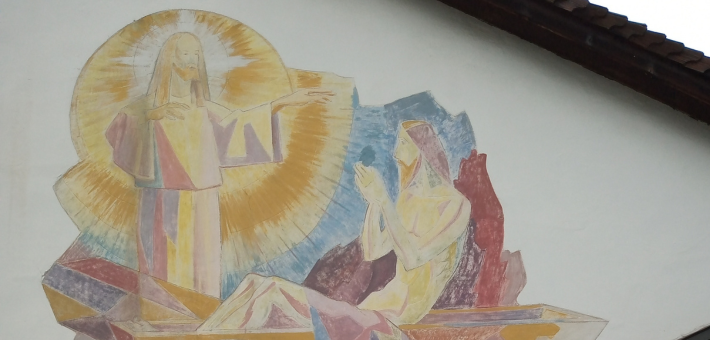Commentary on John 11:32-44
Our passage this week forms the climax of a lengthy narrative in John 11. In this passage, Jesus famously delays his arrival to help his friends Martha, Mary, and Lazarus. His delay not only allows Lazarus to die from his illness (11:17), but it also confuses Jesus’ disciples, who think this is their last trip into a dangerous Judea where they will meet a glorious death with their teacher (11:7–16). Even when Jesus finally comes to Bethany, he at first stays some distance from Mary and Martha’s home and Lazarus’s tomb (11:20, 29).
Having already spoken with Martha in 11:20–27, Jesus now speaks with Mary, who offers the same grief-stricken words as her sister: “Lord, if you had been here, my brother would not have died” (11:32). In the remainder of the passage, Jesus grapples with his own sorrow before calling his friend, Lazarus, from death. John’s Gospel presents this resurrection as the final divisive sign, sparking belief from some and terror from others, thus initiating the plot against Jesus’ own life in 11:45–54.
Selecting John 11:32–44 for All Saints Sunday, creators of the lectionary seem to have been inspired by the story of a saint’s death alongside the reality of his resurrection. Jesus’ raising of Lazarus fulfills his promise to Martha in 11:25–27. For all the joy that may have resulted from Lazarus’s resurrection, however, the Gospel focuses primarily on the lead-up to this event and the ramifications of Jesus’ delayed arrival.
Death has already taken Lazarus; why would Jesus bother to show up now? Shouldn’t Martha and Mary be upset that Jesus took so long to get here? Perhaps their repeated words are tinged with anger? And the crowd of fellow Jews who have faithfully come to the aid of this grieving family certainly speak truth both when some say, “Look how he loved him!” and when others respond, “Isn’t the one who opened the eyes of a blind person also able to keep this one from dying?” (11:36–37, my translation). In other words, if he loved Lazarus so much, why on earth didn’t Jesus show up sooner?
Yet, all the emotions I’ve just described are only implied in our passage; John has left them ambiguous and open to our interpretations. The only person whose emotions are explicitly narrated are those of Jesus. At the sight of Mary and the other Jews weeping (klaiō), Jesus is “deeply moved in the spirit and troubled in himself” (11:33). When he follows Mary’s summons to her brother’s tomb, Jesus cries (11:35).
Although regularly translated “wept,” the verb here is dakruō, which emphasizes the visible tears coming from Jesus’ eyes and not the sound of weeping that klaiō describes (see also the Septuagint rendering of Ezekiel 27:35; Micah 2:6). Jesus’ tears are a tangible sign of his sorrow, and when he arrives at the tomb, he is “again deeply moved” (11:38).
We might be surprised at all this emotion from Jesus; after all, doesn’t he already know what he’s about to do? We see here a sympathetic and empathetic Jesus, a human being who mourns for loved ones who have died and along with other loved ones who remain. Even though Lazarus’s death and resurrection would be “on behalf of the glory of God” (11:4), Jesus does not ignore or remain detached from the very real suffering Lazarus endured and the grief his community experiences. Instead, Jesus mourns too.
This tone is significant when we read of the miracle in 11:38–44. Through his tears, Jesus commands those around him, “Take away the stone” (11:39). While Martha is often maligned for her resistance, she is simply stating facts. Her expectation of her brother’s resurrection on the last day rather than this one is completely understandable (11:24). Indeed, in John 6, Jesus promised a resurrection on the “last day” for those who hear his voice (6:39–44, 54)!
John 11:41–43 records one of only three spoken prayers from Jesus in this Gospel. The prayer, however, brings together themes from previous episodes and points toward future ones. Jesus lifts his eyes, just as he did to observe the hungry crowd gathered around him in 6:5, before offering thanks (6:11). This time, Jesus’ thanksgiving is because he knows his Father always hears him and responds to his prayers, thereby confirming the man’s testimony from 9:31–33 (see also 3:2).
Jesus’ prayer isn’t for himself, nor is it a sort of magical incantation needed for Lazarus to be raised. It is testimony so that the crowd might believe he was sent by God into the world (11:42). Jesus offers a similar explanation in 12:27–30 when he refuses to resist his own coming death. Rather than giving a “loud cry” while hanging on a cross, Jesus’ cry calls Lazarus forth from the tomb and commands his release (11:43–44; see also Matthew 27:46, 50; Mark 15:37; Luke 23:46). Jesus’ emotions in John 11 anticipate his being troubled before his betrayal and death (12:27; 13:21), as well as his disciples’ being troubled about his departure (14:1, 27). But in John’s Gospel, Jesus appears more impacted by the death of his friend and the suffering of his loved ones than by his own impending Passion (see also 18:9).
In John 11:32–44, Jesus acknowledges and enters into the grief that comes when loved ones die. He does not rebuke anyone; rather, he feels with them and joins in the mourning even as he knows Lazarus will soon live again. John’s good news isn’t just that Jesus will call forth loved ones from the tomb; it’s also that Jesus sees and participates in our grief and receives our cries after his delayed arrival. He hears the confusion of gathered crowds who wonder at both his love and his apparent abandonment of those who love him.
Rather than rushing us to resurrection, forcing us to joy without seeing and experiencing the pain of real grief, Jesus cries with us beside the tomb and offers prayers on our behalf, reminding us that he remains the one God sent to give us life that overcomes death.


November 3, 2024